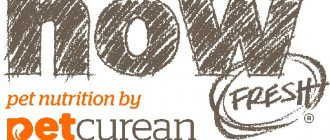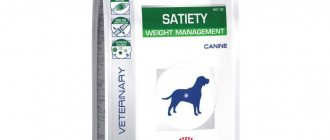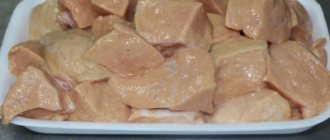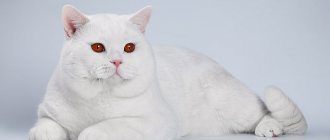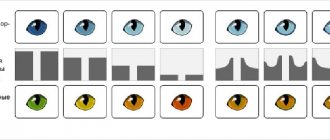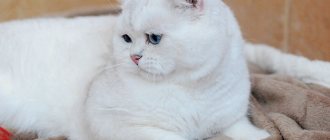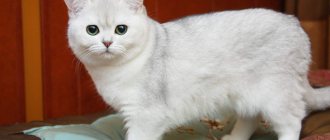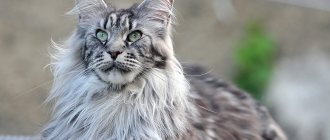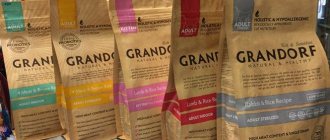The British breed has become widespread among pet lovers due to its pleasant appearance and calm character. To maintain your pet’s health and prolong its life, you should pay close attention to care and feeding, since errors in the diet, quantity and quality of food can cause the development of many diseases of the internal organs.
Power type
Disputes about the choice of food type are still ongoing. There are two options:
- ready-made food;
- natural food.
Ready-made food is produced according to certain standards, implying that the food contains a complex of nutrients, vitamins and elements. In addition, the consistency is taken into account, which corresponds to the age and weight of the animal. The cat's body cannot produce a number of substances, these include taurine, arachidonic acid, vitamin A, so these compounds must be supplied with food.
Manufacturers add the required amount of components to ready-made food, which are calculated based on the age and other parameters of the pet. Some premium products are designed specifically for British shorthair cats, which allows for an individual approach to feeding the animal. For example, manufacturers take into account the size of the jaw and also add special components that improve heart function.
Leading experts do not deny the benefits of natural nutrition. If the owner has chosen to feed the kitten homemade food, you should contact a veterinarian, who will calculate the required amount of food and describe the composition of the dishes.
The menu should cover not only the cat’s energy costs, but also replenish the deficiency of vitamins, minerals and other substances. Selecting food for an animal on your own can result in poisoning, the development of chronic diseases, and even death, so do not neglect going to the doctor.
Thus, what to feed a British kitten must be decided by the owner himself. At the same time, it is important to take into account the type of food your pet received within the walls of the nursery, since a quick transition to another feeding will not lead to the desired result - the kitten’s digestive function may be impaired and an allergy may develop.
When choosing the type of food, it is also worth considering the age and weight of the kitten. Feeding a month-old and a six-month-old pet is very different due to the fact that the body develops and grows, as well as the gradual formation of internal organs.
Many experts are inclined to believe that cat nutrition should follow the one-third rule. The principle is that the diet includes equal parts of both natural products and canned food and dry food. A comprehensive menu saturates the animal’s body with useful substances as much as possible.
Primary requirements
Every cat owner should remember that your pet is one hundred percent a predator. This is where cats differ from dogs - over thousands of years of domestication, dogs have learned to eat the same food that their owner eats, but cats still require meat in order to grow and develop normally.
British babies are no exception in this regard. The basis of their diet should be meat . It is recommended to feed a British cat beef products. This meat is easily digested by your furry pet's delicate stomach.
It is best to feed cooked meat, as raw ground beef may contain parasitic larvae that are dangerous not only to cattle, but also to predators.
© shutterstock
General rules for feeding the British and depending on age
Cats are carnivorous animals, so their diet must contain sufficient protein. The amount of food depends on the individual parameters of the pet. On average, an adult requires about 300 g of food, while kittens only 150 g. You must not exceed the prescribed amount of food, since excess calories leads to excess weight, which, in turn, threatens the development of dangerous diseases of the cardiovascular, gastrointestinal tract. intestinal and endocrine systems.
If the owner has chosen natural food, it is prohibited to give food from the table. Such feeding is dangerous for the pet's life. Natural food involves separate processing of products according to special recipes developed by veterinarians. The difficulty lies in the fact that independent selection of food leads to the fact that the cat’s body receives an insufficient amount of nutrients, and some food is enriched with harmful compounds. Without knowledge of cat physiology, it is difficult to choose the necessary diet.
If the animal has been castrated, veterinarians recommend switching the pet to specialized premium food. This is due to the fact that sterilization increases the risk of developing diseases of the genitourinary system. Changing your diet helps prevent the occurrence of pathologies.
Month
By the first month of life, the kitten, as a rule, gradually moves away from breastfeeding. You can replace mother's milk with cow's milk, but it is better with goat's. During this period, the owner should carefully introduce new products. The food should be soft or liquid and include a large amount of protein. The feeding schedule is five times a day. This is explained by the rapid growth of a young organism, which requires a lot of energy.
Food is heated to a comfortable temperature; you should not give your baby cold or hot food. Experts recommend giving kittens chicken broth, baby purees made from meat.
Gradually, the menu includes more solid food - fresh minced chicken or turkey, finely chopped fruits and vegetables.
Eating ready-made food means choosing premium manufacturers. Cheap products are not suitable for a baby, since such food contains fewer nutrients than a growing body needs.
2 months
At the age of two months, the kittens’ menu gradually includes chicken meat cut into small slices, vegetables, and fruits. Cereals are boiled in a large volume of water so that the consistency is liquid. The diet can be enriched with various cereals.
It is not recommended to reduce the number of meals at two months of age, so kittens are fed about five times a day. At two months, a kitten should not completely give up dairy products. Cow's milk or fermented baked milk, when fed correctly, makes up 50% of all products received.
Six months
At six months, the kitten is given pre-scalded, cooked or raw meat, which is introduced starting from the age of three months. The meat portion should be up to 30-40 g. Preference is given to chicken, turkey, beef and rabbit. These varieties contain the least amount of fat. Chopped vegetables are an obligatory component of the menu. You can also give purees.
At this stage, reduce the amount of feeding to three times a day. Also, six months of age is ideal for introducing ready-made food and a variety of canned food into the diet. Preference is given to premium and super-premium class. The introduction of finished products should be gradual. If your kitten reacts poorly to a new food, you should change the manufacturer or contact your veterinarian.
From one year and older
Upon reaching one year, the kitten turns into a young individual, as a result of which the processes of growth and development and their speed change, and, consequently, energy needs. At this stage, the owner chooses the type of feeding - natural, ready-made food or mixed. In any case, it is recommended to have an examination by a veterinarian and get a professional diet selection.
A one-year-old pet is fed twice a day. The daily food intake is about 250-300 g. The amount of food depends on the initial weight of the pet and its temperament. If the cat is active, it needs more food. For phlegmatic animals, the total weight of food is reduced to the lower limit of the physiological norm in order to avoid the deposition of excess weight.
In what form should the food be given?
A cat needs food to be served either in small pieces or in large pieces from which smaller pieces need to be torn off. Minced meats and pates are not suitable for healthy cats: the absorption of nutrients from them is lower. And it’s not in the nature of a predator to eat formulas similar to those for children.
When preparing meat for serving, even before freezing, it is either divided into large pieces, or mixes of different components cut into smaller pieces are prepared - muscle meat, offal, vegetables if necessary, etc. The required amount of meat (for 1-2 servings) is placed in a bag or plastic container and sent to the freezer for at least 3 days.
If you give your cat large pieces of meat, then one serving may contain only 1-2 types of meat with the addition of, for example, a piece of liver. And then the types of meat alternate. Moreover, it is not necessary to alternate every day: you can feed one type of meat for a week, and then change it. At the same time, of course, we do not forget about calcium and fatty acids, which must enter the body either in the form of food or with dietary supplements.
Mixes can be a complete diet for a longer period, if everything necessary is taken into account. Some people add meat, bones, organs, vegetables, and even eggs to them at once. And then you just need to defrost it, wait until the temperature reaches room temperature, and serve it to the cat.
Mr. Cat recommends: When to introduce complementary foods
Veterinarians advise introducing complementary foods starting at three weeks. At this time, the kitten can gradually accept new food and wean itself off mother's milk. To reduce the body's stress in response to the arrival of an unknown product, complementary foods are introduced gradually.
Start with small amounts and watch the animal's reaction. If the kitten refuses to eat, you should not continue to force feed it.
Getting used to a new place and training to a tray
At first, the kitten will miss its previous home, meows at night, pick it up and stroke it, talk to it. Caring for British kittens at 2 months is exactly like this. At night, you can put him on a warm heating pad, wrapping it in a towel (this will remind him of his mother or the presence of other kittens nearby). Take your time, let the Brit get comfortable.
© shutterstock
If the animal was purchased from a nursery, they are often already litter box trained. If not, then it won't be difficult. After feeding, take your Brit to the toilet. It is better to fill the tray with wood filler. He will like it there and will quickly remember where to go. The tray should always be clean, this is the key to avoiding embarrassment. If there is an embarrassment, then it is worth punishing the kitten.
You shouldn't hit the kitten; a loud sound or clap is enough to make it scared; you can spray it with water.
This will develop a conditioned reflex and after the third time the kitten will understand that this is not worth doing. Never allow a cat's unacceptable behavior to go unpunished.
Proper diet for a British kitten
An optimal diet is important for a growing kitten, as food allows the small body to develop. Before purchasing a pet, you should carefully study the feeding rules.
A small pet requires five to six meals a day. In this case, the daily ration does not exceed 150 g.
The owner should constantly monitor the drinking bowl - it should always be full. Prolonged lack of water leads to dehydration of the body. For kittens, this situation is most critical due to their low body weight and imperfect formation of internal organs and adaptive systems.
If there are signs of hypovitaminosis, you should contact your veterinarian. Your doctor will help you choose the right vitamin complex and other biological supplements.
If an animal has a food allergy, it is recommended to exclude the allergen product from the diet and conduct a veterinary examination.
How to exclude urolithiasis
The cause of urolithiasis (in both humans and animals) is stone-like formations in the urinary tract and kidneys. After castration, the animal's urinary canal (urethra) narrows, which contributes to its obstruction. This means that if there are stones, they will not be able to leave the body naturally.
Therefore, the diet of castrated British cats should contain a minimum content of microelements, which can contribute to the appearance of kidney stones. These are phosphorus, calcium and magnesium.
How and what to feed a neutered cat correctly
What type of nutrition is acceptable for such a “family member”: dry food, canned food, or natural food? There is no clear answer to this question. If you give preference to dry cat food, then the main rule is to stick to one brand. Now on the pet food market there is a huge selection of their manufacturers and various selections, including for neutered cats.
True, there is no significant difference between specialized and ordinary food; when purchasing, you just need to pay attention to the presence of components that oxidize urine (they reduce the likelihood of stone formation). It is better to take premium or super premium food.
Another rule when feeding dry food is for the animal to drink a large amount of water (about 3 times more than the food it eats).
If the cat does not like to drink water, you need to give the food soaked or switch to natural food.
In this case you can use:
- poultry meat,
- beef,
- carrot,
- cabbage,
- offal (liver, lung, heart, chicken gizzards),
- porridge.
Baby puree with beef and vegetables is also perfect. Kefir and cottage cheese are also needed
It is important for a cat to eat a varied diet. You should do this: alternate dry food with canned food, and with a natural diet, use dry food as a supplement
Once the brand of food has been finalized, it is not recommended to change it. It is better to use a product from well-known and trusted manufacturers, because... They are constantly improving the composition of their feed by conducting various additional studies.
The use of fish in the diet of castrated cats is strictly prohibited! Phosphorus contained in it in large quantities is very harmful to them.
Strong and healthy teeth
To ensure that your cat’s teeth remain healthy, special substances are added to elite foods to prevent diseases in this area. With natural feeding, they will be replaced by massagers for teeth and gums, which are available in a large assortment in pet pharmacies and pet stores. There you can also purchase a complex of vitamins C, E and B, which is necessary to maintain the vitality of your pet.
The recommendations given are quite general. A veterinarian will provide a full consultation on proper nutrition for a neutered cat, and he will also advise what to do if the cat does not want to eat its usual food.
Additional Health Support Factors
It is important and necessary for a castrated cat not only to eat properly, but also to be more active. Having no sexual instinct, such an animal focuses on food - it begins to eat a lot and often
This diet, combined with a sedentary lifestyle, can lead to obesity in your pet.
To prevent this from happening, you need to feed the cat often, but in small quantities. You definitely need to give him a weekly fasting day. If the cat has nevertheless gained weight, then you should make his diet lower in calories and increase physical activity (in the form of frequent outdoor games). Excessive lethargy of the purr after surgery is a reason to visit a veterinarian, who can advise him on a course of vitamin B 12 and sex hormones.
The recommendations given are quite general. A veterinarian will provide a full consultation on proper nutrition for a neutered cat, and he will also advise what to do if the cat does not want to eat its usual food. A properly balanced diet and a certain amount of physical activity are the key to ensuring that your pet remains healthy, cheerful and active after the castration procedure for the rest of its life.
Prohibited Products
Including certain foods in the diet of British Shorthair cats can have serious consequences.
- Milk can only be given to kittens up to six months old. This is due to the fact that in childhood a large amount of the enzyme lactase is secreted. This compound is necessary for the digestion of milk, namely, for the destruction of glycosidic bonds of disaccharides. As the pet grows and develops, the production of this enzyme gradually ceases. This situation leads to the fact that the pet cannot completely digest the milk. Consumption of the product as an adult can affect the condition of the digestive system. The clinical picture is usually represented by stool disturbances, general malaise and vomiting.
- Pork is the most dangerous meat in terms of helminthiasis. Most parasites are localized in the internal organs and muscles of cattle. Moreover, pathogens can be in different states - both at the larval and adult stages. As a result of the fact that pigs often receive uncleaned feed, helminths can enter their body. Raw meat containing the pathogen infects the cat. The further clinical picture depends on the type of parasite. But in most cases, helminthic infestation without treatment leads to severe depletion of the body and death of the animal. In the early stages of the disease, complete recovery is possible in 95-100% of cases. Pork is also dangerous in terms of fat content. Excessive intake of lipids and cholesterol can provoke serious diseases of the cardiovascular system in the animal in the future. Therefore, preference is given to dietary meat varieties.
- Food from the owner's table is strictly prohibited for the pet. Fried, spicy, highly salted, smoked foods can lead to poisoning of the body, the development of gastritis and peptic ulcers if the animal is regularly fed incorrectly. The cat is a carnivorous predator, so food should be close to natural nutrition in nature.
- Plants of the legume family create unfavorable conditions in the intestinal lumen - fermentation occurs during digestion. The pet experiences discomfort in the abdomen due to increased formation of gases.
- Chicken and fish bones are dangerous for cats, as there is a risk of them getting into the respiratory tract. In addition, trauma to the soft tissues of the oral cavity is possible, followed by suppuration in the area of damage.
- Dietary supplements, vitamins, and medications intended for humans are strictly prohibited from being given to cats. Despite the fact that usual medications are used in veterinary practice, if a pet becomes ill, they should be purchased through veterinary pharmacies. This is due to the fact that the products have special dosages and dilutions intended for use by animals.
1111
Safety
You need to continue feeding your pet the same types of meat. For safety, it is recommended to boil it. It is not recommended to feed your British cat raw minced meat (this is especially dangerous for veal). If you dare to give your kitten raw meat, it is better to keep it frozen and pour boiling water over it before feeding your pet.
© shutterstock
Vegetables should also be a mandatory element in the diet. It is best to give them at lunchtime along with meat and rice porridge with milk. Otherwise, milk can be excluded from the diet, since at this age the pet’s body has almost no need for dairy products.
You can give your kitten fermented milk products, because it makes your pet’s coat healthier, stronger, silkier and smoother.
Nutrition at five months of age
Time has flown by, and now a real aristocrat is already living in your house. British adults tend to be very fussy when it comes to food. Your pet already chooses what to eat and what not to eat. Pay close attention to what your pet likes most. But you should still give your pet the freedom to choose his own food - this way you can seriously spoil him. You need to maintain a healthy diet.
The British really have a very capricious stomach , which does not accept any food. For example, milk can no longer be given, since it is very difficult to digest in the stomach of an adult animal.
Rules for choosing food
British breed cats are not too picky about the taste of food, so food should be chosen based on the composition, budget and health of the animal. Specialized lines of food for the British contain important microelements; the ratio of products is selected taking into account the needs of representatives of this breed.
You should not mix different types of food (dry, wet) from different manufacturers. You can alternate them. When buying an unfamiliar brand of food, it is better to take several small packs instead of a large economy pack and see how your pet reacts to the new diet.
Animal hygiene and vaccination
Britons also need to be brushed regularly. A rubber, oval brush is perfect for this task. They will not only remove excess hair, but also give a light massage and remove static tension from the British dog’s coat. Their fur is not long, it does not gather in lumps, and there are no difficulties in grooming.
© shutterstock
In winter, you need to touch the wool with a wet hand to create moisture, because... The air is especially dry during the heating season, and the wool fades against its background.
You can bathe your British cat once every six months, with a special shampoo. Water 40 degrees. After bathing the cat, wrap it in a towel and dry it, making sure that it does not catch a cold. Check the ears every week for cleanliness; if there is excess wax, carefully remove it with a bath stick soaked in hydrogen peroxide.
Meeting all family members
Children love animals very much and show great interest in them. Tell your child how to properly pick up a cat, how he shows his dissatisfaction by wagging his tail, and that you shouldn’t squeeze him too hard and drag him around the house.
Perhaps you have another animal at home? Then you should initially not introduce the new guy to the old one for a couple of days. The new one will still get used to it, but the old resident will already feel the emergence of a new one. At the same time , pay sufficient attention to both the first and second pet so that jealousy does not arise. Arrange a meeting with them in a few days. They need to be in the room at this moment, and each of them should have a place to retreat, in case something happens. If an undesirable reaction occurs, limit contact with the animals for a couple of days and introduce them again.
